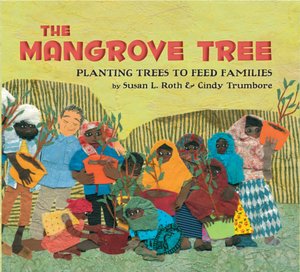 The Mangrove Tree: Planting Trees to Feed Families
The Mangrove Tree: Planting Trees to Feed Families
Susan L. Roth and Cindy Trumbore, Authors
Susan L. Roth, Illustrator
Lee & Low Books Inc., Non-fiction, 2011
Suitable for: Grades 1-6
Themes: Mangrove Forests, Ecological Transformation, Food Production
Opening/Synopsis: By the Red Sea, in the African country of Eritrea, lies a little village called Hargigo. The children play in the dust between houses made of cloth, tin cans, and flattened iron. The families used to be hungry too. But then things began to change…all because of a tree. A Japanese scientist, Dr. Gordon Sato, came up with an idea to plant mangrove trees by the shores of the salty Red Sea because their roots and leaves help them live in salty water. He enlisted the support of the women to plant the mangrove seedlings, and in return they earned money. They planted over 200,000 trees which became a leafy forest four miles long. The trees provided fat leafy food for the goats, sheep and cows, which in turn fed hungry families. The mangrove trees helped the fishing industry in Hargigo. The people use every part of the mangrove tree. Dry branches are used for fires that cook food for families. There is more meat to eat and nourishing milk to drink. There is shade from the heat.
Roth and Trumbore have written a captivating picture book, that alternates with verse on the left side of the story for younger children and straightforward text on the right for older kids. Roth’s illustrations are a unique mixed-media collage of a variety of natural textures that represent many of the items that would be found in the village. A part of the proceeds from the book go to The Manzanar Project to support the mangrove tree planting project.
What I like about this book: This is a remarkable story about how one man made a difference by coming up with a simple solution to feed the poorest people living in the desert. He ultimately transformed this poor village into a self-sufficient community. They feel pride and ownership for their hard work. Dr. Sato continues to dream of planting mangrove forests in many parts of the world, including Peru, Mexico, Somalia, and in desert areas like the Sahara in Africa and Atacama Desert in South America. Dr. Sato is a great role model for kids to learn that they too can make a difference. This is an important book for elementary and middle grade students.
Activity: This beautiful book teaches kids about ecology and finding solutions to feed a hungry world. There is a lengthy Afterword in the back of the book with photos of the work performed by the villagers. It is just as interesting as the book. There is a glossary and interesting web sites. Teachers can use this wonderful resource to encourage kids to discuss and brainstorm how they may individually or as a group make a difference in their school, community or world. It may be as simple as contributing to a food bank, visiting veterans, picking up the trash on the school property, or planting trees around their school and community areas. The possibilities are endless. Everyone can make a difference. Other resource links: Ecology Kids -Ecology Global Network.
To see a complete listing of all the Perfect Picture Books with resources, please visit author Susanna Leonard Hill’s Perfect Picture Books. Or click on the Perfect Picture Book Fridays badge in the right sidebar.